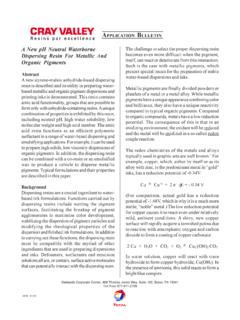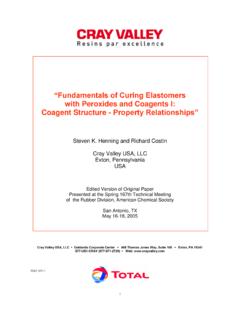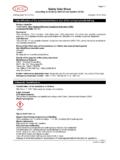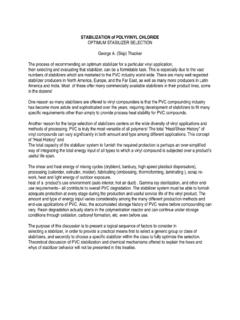Transcription of “Fundamentals of Curing Elastomers with …
1 5546 07/11 fundamentals of Curing Elastomers withPeroxides and Coagents II:Understanding the RelationshipBetween Coagent and Elastomer Steven K. Henning and William M. BoyeCray Valley USA, LLCE xton, PennsylvaniaUSACray Valley USA, LLC Oaklands Corporate Center 468 Thomas Jones Way, Suite 100 Exton, PA 19341 877-US1-CRAY (877-871-2729) Web: , the structure-property relationships of multifunctional monomeric and polymeric coagents were exploredusing a compound based on a standard peroxide -curable elastomer, EPDM. While the system represented a goodmodel to compare the relative activity of coagent structures, it did not address the more complex relationshipsbetween coagent and larger study has been recently completed in which a select group of representative coagents were evaluated in aseries of model formulations based on commercially significant Elastomers that can be cured with organic peroxides(NR, NBR, HNBR, EPDM, EVA, CM, CSM, FEPM, FKM).
2 Cure kinetics and cured physical property dataare summarized. The results are interpreted by considering the relative reactivity of different polymers towardshydrogen abstraction and other radical reactions, and the proposed chemistry of coagent vulcanization. The resultsprovide a better understanding of coagent selection based not only on coagent structure but also on the compositionand microstructure of the elastomer being cured. The investigation furthers the understanding of coagent activity byexploring coagent and elastomer structure-property crosslinking elastomeric polymers, useful compositions can be formed that exhibit physical properties such ashigh tensile strengths, low compression set, recoverable elongations, high tear energies, and improved dynamicperformance.
3 The quantity and quality of the linkages formed by the crosslinking reactions determine the propertiesof the resulting network. Networks formed from radical-based vulcanization typically possess good heat-ageingstability and low compression set. These qualities are a direct manifestation of the chemical composition of thecrosslinks that are formed. Synergistic use of multifunctional coagents can improve upon these properties byincreasing the crosslink density of the network and by altering the crosslink use of organic peroxides in the radical vulcanization of Elastomers is well established. Through model reactionsand analysis of in-situ derived networks, previous work has established the fundamental chemistry and mechanismof radical cure for the basic allyl ester, allylic, and (meth)
4 Acrylate ester functional coagents Other workhas further determined the structure-property relationships of a wide group of coagents through empirical ,3 Most studies made available in the literature which highlight coagents utilize ethylene-propylene or ethylene-propylene-diene rubber as the model elastomer vulcanized by peroxide -coagent ,5,6 Where the use ofcoagents has been expanded into other elastomer grades, the focus is primarily on the elastomer and a smallselection of coagents are utilized to enhance specific physical ,8,9 An expanded survey of several coagenttypes across a wide variety of commercially significant Elastomers has not been design study evaluating a select group of coagents of very different structure and activity in a series of modelformulations based on the most commercially significant Elastomers cured with organic peroxides was recentlycompleted.
5 Comparisons between coagents in a given elastomer and the relative activity of specific coagentsacross a spectrum of Elastomers are presented. The relative activity of coagents was found to be highly dependenton the elastomer in which it is being reacted, as cure kinetics and cured physical property data demonstrate. Theresults provide a better understanding of coagent selection based not only on coagent structure but also the contextof the elastomeric matrix being I outlines the commercially available coagent grades used in the study. They are available from Cray ValleyCompany, Inc. Table II provides a summary of the elastomer grades and manufacturers used in the model compoundformulations evaluated.
6 Both dicumyl peroxide (Di-Cup 40KE, Geo Specialty Chemicals) and 2,5-dimethyl-2,5-di-t-butylperoxyhexane (Varox DBPH 50, Vanderbilt Company, Inc.) were used as Curing agents at 3 phractive peroxide . A listing of model formulations is provided in the I. Coagent identification and commercial II. ASTM designations for common elastomer CompoundingA set of compound evaluations was conducted using six different coagents in model formulations based on ninedifferent Elastomers . To limit systematic error derived from the mixing step, masterbatches containing all ingredientsexcept the coagent and peroxide were prepared in an internal mixer to which the curatives were later added on atwo-roll mill. Curative incorporation time was approximately 7 minutes at an average mixing temperature of 85 each formulation, the selected coagents were evaluated at loading levels of 1, 5, and 10 phr; phr peroxide ( phr actives) was also added to the compound.
7 A control compound for each formulation using no coagent( peroxide only) was included for TO MERAS TMCO MMERCIALTYPEDES IGNATIONGRADE natural rubberNRSM R CV-60nitrile rubberNBRN ipol DN 3335, Zeo n Ch emicalshydrogenated nitrile rubberHNB RZetpol 2010L, Zeon Chemicalsethylene propylene diene rubberEP D MNordel IP4640, Dow Chemicalethylene-vinyl acetate copolymerEV MLevapren 600HV, Lan xes schlorosulfonated poly(ethylene)CS MHypalon 40, Du Po nt Elas to merschlorinated poly(ethylene)CMTyrin 0136, Do w Ch emicalfluorocarbon rubberFKMVit o n GF-S, DuPont Elas tomersfluorocarbon rubberFEPMA flas 150P, A GC A mericasCOAGENT DESCRIPTION CODE TYPE COMMERCIAL PRODUCT trifunctional (meth)acrylate ester TM A I N,N -m-phe nylene dimaleimide PDM I poly(butadiene) diacrylate PBDDA hybrid triallyl cyanurate TAC II triallyl isocyanurate TAIC II high vinyl poly(butadiene) HVPBD II Ricon 154 4 Physical TestingCure kinetics.
8 A moving die rheometer (MDR, TechPro MDPT) was used to determine the extent of cure andcure kinetics according to ASTM D 5289. The cure temperature used was dependent upon the peroxide (160 Cfor dicumyl peroxide , 180 C for 2,5-dimethyl-2,5-di-t-butylperoxyhexane) . Cure rheometry was conducted usingan arc deflection of 3 . Cure times were sufficiently long to ensure near complete decomposition of the peroxide (35 minutes for dicumyl peroxide , 15 minutes for 2,5-dimethyl-2,5-di-t-butylperoxyhexane) .Tensile and compression properties. Physical testing was performed on samples cured in a press under the sametemperature and time conditions outlined above. Tensile, elongation and tear data was acquired on a tensile machine(Thwing-Albert Materials Tester) following ASTM D 412 and D 624.
9 Compression set was evaluated afterheating at 100 C (200 C for FKM, FEPM model formulations) for 22 hours following ASTM D AND DISCUSSIONAn important factor that determines the final architecture of the vulcanized network is the relative reactivity betweencoagent and the polymer chain towards radicals. Polymer radicals can be formed when a radical species abstractshydrogen from the polymer chain. The ease of abstraction is dependent on the structure of the polymer. A listquantifying the relative difficulty of hydrogen abstraction from various chemical groups is For mostcommercially relevant polymers cured by peroxides, the following list is sufficient to describe the ease that polymerradicals can form through hydrogen abstraction based on the microstructural elements of the polymer:benzylic = allylic > tertiary carbon > secondary carbon > primary carbon > vinyl >> phenylBy default, the above list can also be used to determine the relative reactivity of polymers to peroxide cureassuming attack by an alkoxy radical.
10 For poly(dienes), other factors are also of importance in comparing therelative reactivity to hydrogen abstraction, including steric hindrance and the effects of addition across C=C unsaturation is the other mechanism by which polymer radicals can form. Terminal,or pendant double bonds (vinyl) have low steric hindrance and are more likely to participate in addition reactionthan internal double bonds (cis/trans). Radical addition reactions compete with allylic abstraction to form polymerradical species. Crosslinks can be subsequently formed through polymer radical coupling Cure of ElastomersIn order to provide a baseline of polymer reactivity, an equivalent amount of peroxide was added to the elastomersin our evaluation group, and the delta torque (MH-ML) was determined by rheometry.











![18.2% Ethylene - Vinyl Acetate [EVA] copolymer](/cache/preview/9/f/4/0/6/b/c/7/thumb-9f406bc7cf3a6248c0295bb5a269f78e.jpg)





